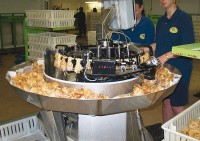There are several beak trimming methods which can be classified into mechanical, electrical, hot-blade, and infrared, but the HB trimming method is the most commonly used in commercial laying hens. The HB technique involves using a guillotine blade that is heated up to 750°C to cut beaks without anesthetic. In general, one-third to one-half of the lower and upper beak is removed and cauterized simultaneously. However, cauterization may cause tissue damage which results in removal of large amount of beak tissue. If HB trimming is done improperly, beak trimmed birds can suffer from open wounds which lead to bleeding, inflammation, infection, and pain. It is not uncommon to see uneven or variable beak length when HB trimming methods are performed by inexperience human operators.
Infrared beam is a new beak trimming treatment that may provide alternative solutions to HB trimming methods. IR trimming is an automated process that birds are inserted into head holders and an infrared beam is focused on the rhamphotheca that is a keratinized layer covering the surface of the beak. At the same time, the infrared beam also damages the dermis and subdermal tissues that found underneath the rhamphotheca layer and the tip of the beak will slowly erode away within 7 to 10 days.

